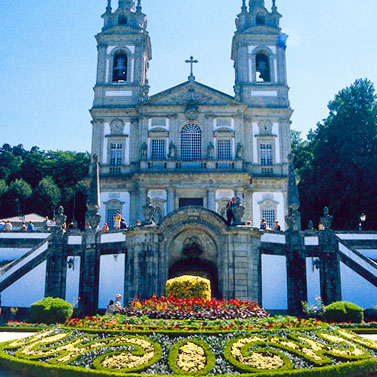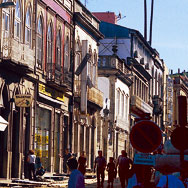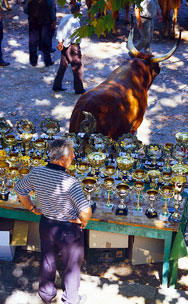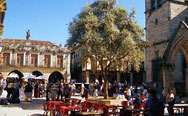- Villa search

- Canaries
- Caribbean
- Croatia, Bulgaria and Hungary
- Cyprus
- Florida
- France and Corsica
- Greece
- Italy
- Lakes and Mountains
- Madeira
- Malta and Gozo
- Portugal
- South Africa
- Spain - Balearics
Information
Related articles

Bom Jesus do Monte
'Money, much of it from the EU, is being poured into improving the infrastructure. There's a concerted effort to compete with southern Portugal for the tourist trade'
Built in the 18th century, this stairway to heaven was a huge visual aid for getting across the Christian message to a largely illiterate people. Even today, devout pilgrims sometimes climb it on their hands and knees. But if this doesn’t appeal, there’s a nifty water-powered funicular railway right next to the stairway.
My next stop was Guimarães, a short drive south from Braga, which hosts one of Portugal’s biggest festivals. A series of delightful interlinked squares, narrow cobbled streets, overhanging balconies, mediaeval churches and convents, its centre was busy but not overcrowded. I walked across the Largo da Oliveira and through a stately arcade to the Praça de Santiago, another lovely square which contained a flea market.

Guimar�es street with palms
A further hike past two convents brought me to a large and leafy park on a hill to the north of the town. And beyond the park, I stumbled across the highlight of my visit. In a huge oval arena under the trees, hundreds of enormous bulls were gathering. Slithering down ramps from surrounding lorries, standing around under the trees, or parading around the showground, they were an amazing sight.
It was a beauty contest. Proud farmers were waxing horns and brushing coats. Ribbon-bedecked bulls were attached in pairs by beautiful ornamental wooden yolks. Some, getting frustrated by all the fuss, threw prima donna tantrums, bellowing deafeningly. At one end of the parade ground, a table-full of silver cups awaited the judging.

Beauty of the beast
On my way back to Braga, I detoured to the Celtic hill settlement of Citânia de Briteiros, six miles outside the town. More than 40 citânias have been identified in the area, and the one at Briteiras is a cracker. On a hilltop, with terrific views in all directions, the site is mind-blowing.
Completely surrounded by massive inner and outer walls, the remains consist of 150 or so small circular huts (several of which have been reconstructed), some much larger circular and oblong buildings, an impressive cistern, and a maze of clearly marked paths, stone guttering and a fountain.
Coasting the coast
The following day, I drove west to take a look at the Costa Verde south of Viana do Castelo. Not far down the coast is the pretty village of São Bartholomeu do Mar, which earns its living from fishing and farming.
The villagers harvest seaweed, which is dried and used as fertiliser (if you’re lucky, they’ll be using beautiful ox carts to carry the seaweed; if not, they’ll be using more prosaic tractors). Beyond São Bartholomeu do Mar, Esposende has a museum, Póvoa de Varzim a fort as well as a casino, and Vila do Conde a huge convent, a splendid 17th century fortress, and a fascinating lace-making school and museum.

Oliveira, with the Igreja de Nossa Senhora da Oliveira (Church of Our Lady of the Olive Tree)
The coast has many sandy beaches, but the Atlantic hereabouts can be perishing, and the weather wet, even at the height of summer. Perhaps that’s what has saved it from over-commercialisation.
As I joined Porto’s bypass, I tried to sum up my experience of the Minho as a whole. There’s a lot going on. Money, much of it from the European Union, is being poured into improving the infrastructure. There’s a concerted effort to compete with southern Portugal for the tourist trade.
Yet for all its efforts to modernise, its greatest appeal arises from its traditions. It glows in the memory like some rich tapestry, saturated with its colourful history, stately religion, vibrant festivals, bustling markets, beautiful countryside and attractive coastline. Add to that one of the best climates in Europe, and you’ve got a destination for a holiday – or even for a more permanent place in the sun – to die for.
Want to know more?
Regional tourism
- Braga Tourist Office, tel 00351 253 262 550
- Upper Minho Tourism, www.rtam.pt
- Portugal Tourist Office, www.visitportugal.com
The author
• Jos Simon, e-mail simon_lj@msn.com
home | destinations and editorial | villa search | property for sale | car hire | flights | services
villaseek blog | contact villaseek | links and resources | advertise your villa© Dune Root Ltd and Villaseek.com 2012 - Caribbean
- Canaries